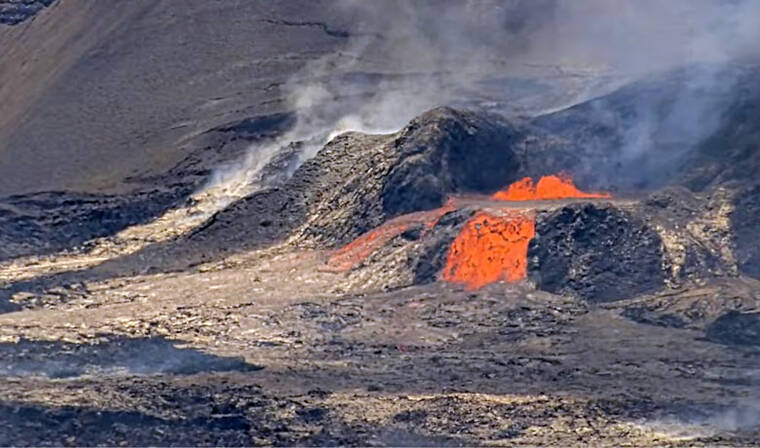1/2
Swipe or click to see more
VIDEO COURTESY USGS
A live view from the eastern rim of the caldera.

2/2
Swipe or click to see more
COURTESY USGS
Scientists at Hawaiian Volcano Observatory said “episode 15” of the ongoing eruption commenced at 12:04 p.m. today.


It’s on again.
Scientists at Hawaiian Volcano Observatory said “episode 15” of the ongoing eruption commenced at 12:04 p.m. today “with the onset of vigorous overflows from the north vent,” along with “continuing cycles of lava rise, fountaining and vigorous overflows, and drainback events.”
Prior to “episode 15,” scientists said there were eight cyclic, small spatter fountains in the north vent that began at about 9:27 a.m.
A ninth cycle occurred from 12:05 to 12:19 p.m., producing vigorous overflows extending 150 to 300 feet into Halema‘uma‘u Crater.
These continued to increase in intensity, producing fountains up to 30 to 50 feet high from the north vent. Then around noon, the south vent also became active, and also began feeding a lava flow onto the crater floor.
As of about 2 p.m., flows from both vents covered about 5% of the Halemaʻumaʻu Crater floor. High fountaining had not yet begun, but was expected to follow the cyclic fountains and drainbacks as it did during episode 14.
Don’t miss out on what’s happening!
Stay in touch with breaking news, as it happens, conveniently in your email inbox. It’s FREE!
In the 14th episode, lava fountains reached more than 600 feet high at the summit caldera of Kilauea.
The current on-again, off-again eruption began Dec. 23 with each episode lasting for between 13 hours to 8 days, separated by pauses in eruptive activity lasting from less than 24 hours to 12 days, according to HVO.
All episodes have been confined to Halemaʻumaʻu Crater within Kaluapele, the summit caldera, of Hawai‘i Volcanoes National Park.
No significant changes have been noted along Kilauea’s East Rift Zone or Southwest Rift Zone.
The Kilauea volcano alert level remains at watch, and the aviation color code remains at orange.
A livestream of the Kilauea summit is available at this link.
Hazards from the eruption include vog, or volcanic smog, downwind of Kilauea, Pele’s hair and other volcanic fragments from lava fountains.
Pele’s hair are thin, golden-brown strands of volcanic glass formed during eruptions when molten lava stretches and cools quickly, according to HVO, and the tiny fibers can get lodged in skin and eyes.
Vog information is available at vog.ivhhn.org.
